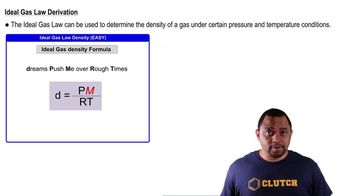Acetic acid tends to form dimers, (CH3CO2H2), because of hydrogen bonding: The equilibrium constant Kc for this reaction is 1.51⨉102 in benzene solution but only 3.7⨉10-2 in water solution. (a) Calculate the ratio of dimers to monomers for 0.100 M acetic acid in benzene.
Ch.15 - Chemical Equilibrium
Chapter 15, Problem 156
A 79.2 g chunk of dry ice (solid CO2) and 30.0 g of graphite (carbon) were placed in an empty 5.00-L container, and the mixture was heated to achieve equilibrium. The reaction isCO 1g2 + C s ∆ 2 CO g(b) What is the value of Kp at 1100 K if the gas density at 1100 K is 16.9 g/L?
 Verified step by step guidance
Verified step by step guidance1
Identify the reaction: \( \text{CO}(g) + \text{C}(s) \rightleftharpoons 2\text{CO}(g) \). Note that carbon in solid form does not appear in the equilibrium expression.
Use the ideal gas law to find the total moles of gas at equilibrium. The gas density is given as 16.9 g/L, and the volume is 5.00 L. Calculate the total mass of the gas using density and volume, then convert this mass to moles using the molar mass of CO.
Set up the equilibrium expression for \( K_p \): \( K_p = \frac{P_{\text{CO}}^2}{P_{\text{CO}}} \). Since the reaction involves gases, use partial pressures in the expression.
Calculate the partial pressure of CO at equilibrium. Use the moles of CO found from the ideal gas law and the volume of the container to find the partial pressure using \( P = \frac{nRT}{V} \).
Substitute the partial pressures into the equilibrium expression to solve for \( K_p \).

Verified video answer for a similar problem:
This video solution was recommended by our tutors as helpful for the problem above.
Video duration:
8mWas this helpful?
Key Concepts
Here are the essential concepts you must grasp in order to answer the question correctly.
Equilibrium Constant (Kp)
The equilibrium constant, Kp, is a numerical value that expresses the ratio of the partial pressures of the products to the reactants at equilibrium for a given reaction at a specific temperature. It is calculated using the formula Kp = (P_CO)^2 / (P_C)^1, where P_CO is the partial pressure of carbon monoxide and P_C is the partial pressure of carbon. Understanding Kp is essential for predicting the direction of the reaction and the concentrations of reactants and products at equilibrium.
Recommended video:
Guided course

Equilibrium Constant Expressions
Gas Density and Ideal Gas Law
Gas density is defined as the mass of gas per unit volume, typically expressed in grams per liter (g/L). The ideal gas law, PV = nRT, relates pressure (P), volume (V), number of moles (n), the ideal gas constant (R), and temperature (T). By using the gas density provided, one can determine the number of moles of gas present in the container, which is crucial for calculating the partial pressures needed to find Kp.
Recommended video:
Guided course

Density from Ideal Gas Law
Stoichiometry of the Reaction
Stoichiometry involves the calculation of reactants and products in chemical reactions based on balanced equations. In this case, the reaction between solid carbon and carbon dioxide to form carbon monoxide must be balanced to determine the mole ratios of the reactants and products. This understanding is vital for calculating the concentrations of each species at equilibrium, which directly influences the value of Kp.
Recommended video:
Guided course

Stoichiometry Concept
Related Practice
Textbook Question
Textbook Question
Acetic acid tends to form dimers, (CH3CO2H2), because of hydrogen bonding: The equilibrium constant Kc for this reaction is 1.51⨉102 in benzene solution but only 3.7⨉10-2 in water solution. (b) Calculate the ratio of dimers to monomers for 0.100 M acetic acid in water.
Textbook Question
A 14.58 g quantity of N2O4 was placed in a 1.000-L reaction vessel at 400 K. The N2O4 decomposed to an equilibrium mix- ture of N2O4 and NO2 that had a total pressure of 9.15 atm.(b) How much heat (in kilojoules) was absorbed when the N2O4 decomposed to give the equilibrium mixture? (Stan- dard heats of formation may be found in Appendix B.)
Textbook Question
Consider the sublimation of mothballs at 27 °C in a room having dimensions 8.0 ft ⨉ 10.0 ft ⨉ 8.0 ft. Assume that the mothballs are pure solid naphthalene (density 1.16 g/cm3) and that they are spheres with a diameter of 12.0 mm. The equilibrium constant Kc for the sublimation of naphthalene is 5.40⨉10-6 at 27 °C. C10H8(s) ⇌ C10H8(g) (a) When excess mothballs are present, how many gaseous naphthalene molecules are in the room at equilibrium?
